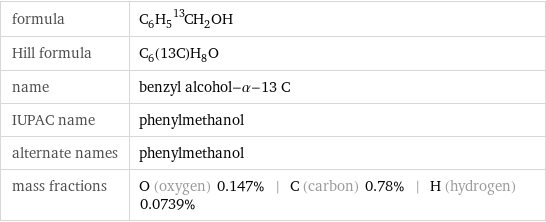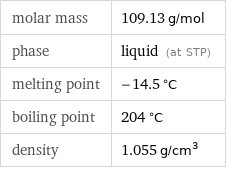Input interpretation

benzyl alcohol-α-13 C
Chemical names and formulas

formula | C_6H_5^13CH_2OH Hill formula | C_6(13C)H_8O name | benzyl alcohol-α-13 C IUPAC name | phenylmethanol alternate names | phenylmethanol mass fractions | O (oxygen) 0.147% | C (carbon) 0.78% | H (hydrogen) 0.0739%
Lewis structure

Draw the Lewis structure of benzyl alcohol-α-13 C. Start by drawing the overall structure of the molecule, ignoring potential double and triple bonds: Count the total valence electrons of the carbon (n_C, val = 4), hydrogen (n_H, val = 1), and oxygen (n_O, val = 6) atoms: 7 n_C, val + 8 n_H, val + n_O, val = 42 Calculate the number of electrons needed to completely fill the valence shells for carbon (n_C, full = 8), hydrogen (n_H, full = 2), and oxygen (n_O, full = 8): 7 n_C, full + 8 n_H, full + n_O, full = 80 Subtracting these two numbers shows that 80 - 42 = 38 bonding electrons are needed. Each bond has two electrons, so in addition to the 16 bonds already present in the diagram add 3 bonds. To minimize formal charge carbon wants 4 bonds. Identify the atoms that want additional bonds and the number of electrons remaining on each atom: Fill in the 3 bonds by pairing electrons between adjacent highlighted atoms. Note that the six atom ring is aromatic, so that the single and double bonds may be rearranged: Answer: | |
Basic properties

molar mass | 109.13 g/mol phase | liquid (at STP) melting point | -14.5 °C boiling point | 204 °C density | 1.055 g/cm^3
Units

Liquid properties (at STP)

density | 1.055 g/cm^3 refractive index | 1.54
Units

Non-standard atom properties

C-13 | 1
Chemical identifiers

CAS number | 54522-91-7 PubChem CID number | 12203066 PubChem SID number | 24856501 SMILES identifier | C1=CC=C(C=C1)CO InChI identifier | InChI=1/C7H8O/c8-6-7-4-2-1-3-5-7/h1-5, 8H, 6H2/i6+1 MDL number | MFCD00037420
Safety properties

flash point | 100.6 °C